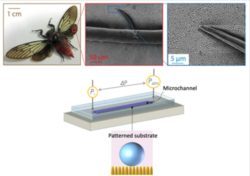Drag Reduction on Natural Superhydrophobic Surfaces
- Academic lead
- Sepideh Khodaparast (Mechanical Engineering)
- Co-supervisor(s)
- Nicole Hondow (Chemical and Process Engineering)
- Project themes
- Energy and Transport, Underpinning Methods for Fluid Dynamics
Various micro/nano-patterned superhydrophobic surfaces have proved effective in significantly reducing the frictional loss on solid boundaries, thanks to providing stable Cassie wetting conditions in which only a fraction of the fluid experiences the no-slip boundary condition. This project focuses on experimental characterisation of laminar flow drag reduction on natural superhydrophobic surfaces found in insect wings. Topographic surface characterisation will be performed by a variety of advanced microscopy techniques, while drag reduction behaviour of micropatterned surfaces will be monitored under laminar flow conditions in microfluidic setups that allow precise control of the geometry and thus shear stress magnitude. The drag reduction capacity of different arrangements of surface features with various dimensions, shape and arrangement will be compared using microfluidic platforms that are equipped with pressure measurement sensors in order to accurately quantify the frictional pressure drop across the fluid circuit. Simultaneously, microparticle image velocimetry technique will be employed to probe modification of flow structure in the vicinity of the superhydrophobic surfaces. Through quantitative advanced microscopy and microfluidic experiments, this PhD project maps wettability and drag-reducing functionality of a variety of naturally available micro- and nano-patterned surfaces in order to create a comprehensive guideline for fabrication of future biomimetic functional surfaces.

